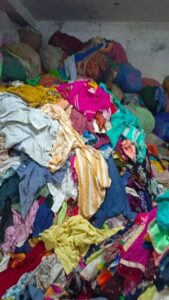Cotton Hosiery Wastes Product Description
Cotton hosiery wastes are by-products generated during the manufacturing of cotton hosiery products, such as socks, tights, and leggings. These wastes primarily consist of leftover cotton fibers, small fabric scraps, and defective hosiery items that cannot be sold. Despite being considered waste, cotton hosiery wastes are highly valuable due to their natural properties, sustainability, and versatility. They can be repurposed for various applications, including textile recycling, stuffing materials, and even as raw materials for new textile products. The use of cotton hosiery wastes contributes to reducing environmental impact by minimizing landfill waste and promoting a circular economy.
Uses of Cotton Hosiery Wastes
- Textile Recycling: Cotton hosiery wastes can be processed and recycled into new yarns and fabrics, reducing the need for virgin cotton.
- Stuffing Material: The soft and absorbent nature of cotton makes it an excellent stuffing material for pillows, cushions, and toys.
- Insulation: Cotton wastes can be used as insulation material in various applications, providing thermal and acoustic benefits.
- Cleaning Rags: The absorbent properties of cotton make it ideal for use as cleaning rags in industrial and household settings.
- Craft Projects: Cotton hosiery wastes can be utilized in various DIY and craft projects, such as quilting, patchwork, and textile art.
Technical Data
| Property | Description |
|---|---|
| Material Composition | 100% Cotton |
| Color | Varies (depends on production) |
| Weight | Approximately 200-300 grams per kg |
| Moisture Content | 8-10% |
| Size | Varies (typically small scraps) |
| Absorbency | High (excellent moisture absorption) |
| Biodegradability | Fully biodegradable |
| Recyclability | High (can be recycled into new textiles) |
| Applications | Textile recycling, stuffing, insulation, cleaning rags, crafts |
Summary
Cotton hosiery wastes are a sustainable and versatile resource that can be effectively repurposed for various applications. By utilizing these wastes, industries can contribute to environmental conservation while also creating new products. The technical data highlights the properties that make cotton hosiery wastes an attractive option for recycling and reuse, promoting a more sustainable future in the textile industry.

